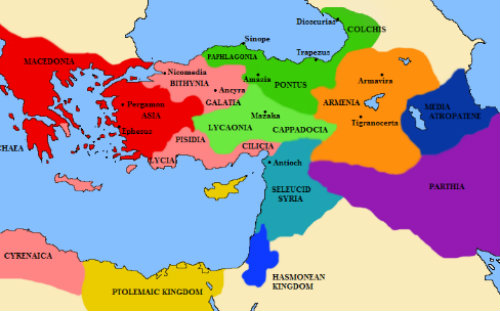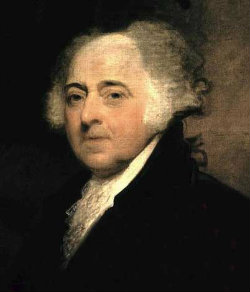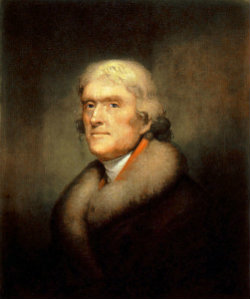Concept Attainment in Social Studies Class
A MiddleWeb Blog
 Attributes vs. the Whole
Attributes vs. the Whole
The concept attainment learning strategy is a way of harnessing the scientific process — using it to elucidate the properties of a particular idea in order to better understand that idea.
This process, developed by cognitive psychologists, has students learn by logic and contrast. Often positive exemplars are used on one side and negative on the other (what does it look like, what does it NOT look like), and in the end, students are better able to identify and explain a concept because of having understood its attributes. (Here’s an art example.)
Sadducees and Pharisees
This model, often used in science and math classes, can be adapted for use in history and social studies classes as well. Last year, we used concept attainment in one of our classes to show the differences between the Sadducees and Pharisees (groups living under Hasmonean rule). These two groups had very different ideas about life and religion–in fact they were, in many cases, diametrically opposed.
We started by showing the students one set of opposing characteristics: “strict” and “flexible.” We put these words on different sides of the board (strict on the left, and flexible on the right). We then introduced another set of opposing characteristics: “wealthy people” and “common people.” Wealthy people went on the left, and common people on the right.
We continued introducing characteristics about the Pharisees and Sadducees, soon asking the students to predict what side of the board the characteristic should go on. Each new set of characteristics became more specific, and eventually the students were able to predict how court decisions would be made by one side of the board or the other.
So far in this process, the students had been constructing the idea of Pharisee and Sadducee characteristics before they had been introduced to those identifying labels. Once they understood the concept behind the two anonymous groups, we labeled the left side of the board “Sadducee” and the right side “Pharisee.”
In previous years, when we used a more traditional approach, our students had a hard time remembering which group had which characteristics. Because we used this lesson model to introduce these ideas, the students built the idea of Pharisee before learning the name. They had a significantly higher rate of retention of this information than they had in previous years.
Federalists vs. Democratic Republicans
After our success with the Sadducees and Pharisees, we wondered if this concept was something we could use in our U.S. history class–specifically with Federalists and Democratic Republicans. While these two groups were not always diametrically opposed, often they were, and we thought this strategy might help our students to be able to see the differences in ideas between these two political parties.
While concept attainment was the model for what we did, we certainly took liberties with it in order to meet our needs. You can use a visual of an upside down triangle to imagine how to apply this: you start with the broadest attributes, then move down to the more specific attributes–then at the bottom, you can label the idea.
First, we started with some broader ideas – e.g., weaker federal government versus stronger federal government – and put them on the board in diametric opposition. Once these two concepts were on the board, we brought out attributes of stronger state/local government and weaker state/local government and asked the students to identify to which group these attributes would go (remember they still have no identifying labels for the groups).
We continued to bring in defining characteristics of each group, getting more specific as more attributes were named:
- The idea that the federal government should control the country’s money vs. the idea that state governments/local governments should be able to control money
- The idea that the federal government could occasionally limit the rights of the people for the good of the country vs. the idea that individual rights should be protected over the needs of the country as a whole
- John Adams vs. Thomas Jefferson
For each of these ideas, students decided which group they belonged in. It is a lesson in categorization–matching like concepts to other like concepts. For many students, the kind of activity helps make connections and ultimately understand the unit more completely as we go through it.
And yes, some of the ideas and attributes simplify complex subjects, but when the students are introduced to them as a whole, it can help them grasp the major ideological and political differences between these two opposing groups. (We were also able to preview some of the key points of contention at that time: the National Bank, the Alien and Sedition Acts, etc.)
Finally, at the end, once we’ve gone from the most general to the most specific, we label the groups “Federalist” and “Democratic Republican.”
Then we tie this to one of the themes of the course:
The United States functions by maintaining a balance between opposing groups/powers.
We explain that since the founding of the U.S., political parties (a bunch of people who pretty much agree on political matters) have been in existence. In upcoming lessons, we will learn about two of the United States’ earliest political parties who were in opposition to each other.
For closure, we ask the students to write a sentence describing a person from each of the political parties. We deliberately ask for a sentence to avoid a list. Students then have to synthesize the attributes of a Federalist or Democratic Republican and be able to succinctly explain what a person from that political party believed.
The potential of concept attainment
Concept attainment is something that we have only tried a few times in our history classroom, but it seems like the kind of strategy that would have wide-reaching applications across content and grade levels.
The idea that the names and labels are less important than the defining attributes of a thing is a powerful idea, and one that will help us to re-think the way that we teach certain concepts in history.
Have you used concept attainment in your history classroom? Can you think of other topics this lesson model would resonate with?




































Jody, I was pleased to read your social studio examples of the Taba Attainment strategy. Hilda Taba was a major force in curriculum especially for social studies and focused on inductive reasoning. SHe died in 1967 which was probably before your time, however her works are readily available. As a social studies teacher you should know about her and give her credit. Her research supports what you are saying except for the fact that the origin is not the math and science teachers even though they use her ideas. It is unfortunate that many people especially those in the social studies do not know or do not give her credit for her pioneering efforts and successes.
So it sounds like this is best used when there are stark contrasts between things. Am I getting the gist right?
Mary– thank you so much for bringing that to my attention. It’s true, that I haven’t seen Taba credited for this model in pedagogy texts, which is where Shara and I read about this model for the first time– oftener, we read about Jerome Bruner. Absolutely credit to Taba for her contributions to the inductive reasoning model.
Marsha– this is often how we use it, but I would love to hear from others who have used it in contexts with contrasts not quite as stark. Recently I used it to delineate between expository text and narrative text.
Thank you so much! I have shared this with my staff!!!! :-)